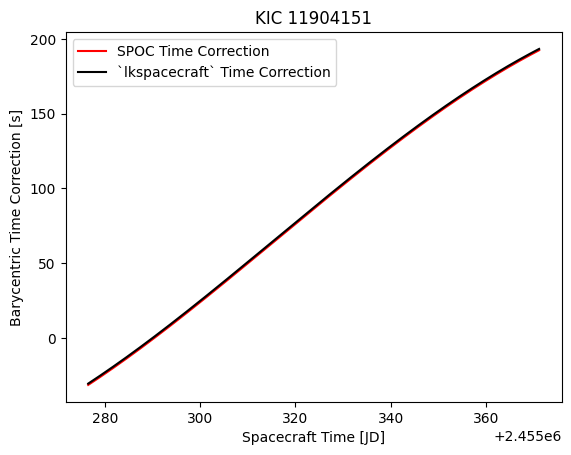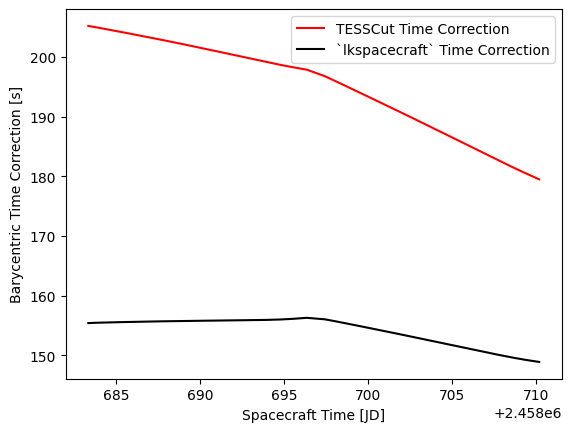Calculating the Barycentric Timing Correction#
When we observe stars using space-based telescopes, such as Kepler and TESS, the arrival time of photons is different to the time they would arrive at the solar system barycenter. For example, If the spacecraft is between the target and the solar system barycenter, the photons will arrive early. So that we can inter compare observations from different facilities, we provide the measurement along with the time those photons would have reached the solar system barycenter.
lkspacecraft provdes a way to calculate this timing correction based on
The time of the measurement at the spacecraft
The position of the spacecraft at that time
The position of the target
This example shows you how to calculate this for Kepler and TESS.
Kepler example#
Here we show how to calculate the barycenteric time correction. We’ll use lksearch to download some Kepler data with which to test. We’ll open the .fits file using astropy.
[1]:
from lkspacecraft import KeplerSpacecraft
from lksearch import KeplerSearch
import numpy as np
from astropy.io import fits
from astropy.time import Time
[2]:
# Download the file, obtain the local filename
fname = KeplerSearch("Kepler-10", exptime=1800).timeseries[5].download()["Local Path"][0]
# Open using astropy
hdulist = fits.open(fname)
Downloading products: 100%|███████████████████████| 1/1 [00:00<00:00, 1.62it/s]
We’re going to use lkspacecraft to create the KeplerSpacecraft object
[3]:
ks = KeplerSpacecraft()
Now we’ll get the time array out of the data
[4]:
time, time_corr = hdulist[1].data['TIME'], hdulist[1].data['TIMECORR']
k = np.isfinite(time)
time, time_corr = time[k], time_corr[k]
SPOC data contains two time extensions:
TIME: the time of the observations in the Barycentric Dynamical Time scale (TDB) as a Barycentric Julian Dates (i.e. time at the solar system barycenter)TIMECORR: the time correction applied to the original spacecraft time, to obtainTIME
lksearch only works with spacecraft time. So we need to remove the SPOC applied time correction
[5]:
t = time - time_corr
Kepler times are actually given in Barycentric Kepler Julian Date, which is BJD minus a constant. The constant is 2454833, we also store it for you in lkspacecraft.
[6]:
ks.time_offset
[6]:
2454833
[7]:
t = time - time_corr + ks.time_offset
[8]:
t
[8]:
array([2455276.49115492, 2455276.51158862, 2455276.53202212, ...,
2455371.11916292, 2455371.13959652, 2455371.16003002])
We will convert our time from a numpy array to an astropy.time.Time object, which will ensure this is a valid time.
[9]:
t = Time(t, format='jd')
To calculate the arrival time we will need to know where the target is in the sky, which we can obtain from the fits file.
[10]:
ra, dec = hdulist[1].header['RA_OBJ'], hdulist[1].header['DEC_OBJ']
Now we have the spacecraft time in julian date and target coordinates, we can calculate the time correction.
[11]:
ks.get_barycentric_time_correction(time=t, ra=ra, dec=dec)
[11]:
array([-30.41441299, -30.37170985, -30.32899557, ..., 193.18638174,
193.22012183, 193.25384805])
This is the correction that should be applied to the spacecraft time in order to give the light arrival time at the barycenter. Let’s compare!
[20]:
import matplotlib.pyplot as plt
[21]:
fig, ax = plt.subplots()
ax.plot(t.jd, time_corr * 86400, label='SPOC Time Correction', c='r')
ax.plot(t.jd, ks.get_barycentric_time_correction(time=t, ra=ra, dec=dec), label='`lkspacecraft` Time Correction', c='k')
ax.legend()
ax.set(xlabel='Spacecraft Time [JD]', ylabel='Barycentric Time Correction [s]', title=hdulist[0].header['OBJECT']);

Looks like our correction is working!
This has given us the number of seconds to apply to convert our time at the spacecraft into TDB.
TESS Example#
TESS has a much wider FOV than the Kepler mission, and so there can be a significant difference between the barycentric correction for a target at the center of the field compared with a target at the edge of the field.
This effect is not currently taken into account in TESScut TPFs. Let’s use lkspacecraft to fix this.
[14]:
from lksearch import TESSSearch
from lkspacecraft import TESSSpacecraft
[15]:
# Download a TESScut TPF file, obtain the local filename
fname = TESSSearch("Kepler-10", hlsp=False).tesscut[0].download()['Local Path'][0]
# Open using astropy
hdulist = fits.open(fname)
Downloading TESScut: 100%|████████████████████████| 1/1 [00:02<00:00, 2.27s/it]
[16]:
ra, dec = hdulist[1].header['RA_OBJ'], hdulist[1].header['DEC_OBJ']
We’ll load a new spacecraft this time, TESS!
[17]:
ts = TESSSpacecraft()
In TESScut data there is a correction applied, but this is the correction at the middle of the FFI. Let’s remove it
[ ]:
time, time_corr = hdulist[1].data['TIME'], hdulist[1].data['TIMECORR']
k = np.isfinite(time)
time, time_corr = time[k], time_corr[k]
Note that TESS gives times in Barycentric TESS Julian Date which is offset from BJD by
[ ]:
ts.time_offset
We calculate the time at the spacecraft using
[ ]:
t = Time(time - time_corr + ts.time_offset, format='jd')
Now we can calculate the barycentric time correction, i.e. the number of seconds to apply to the time at the spacecraft to obtain the time at the barycenter in TDB scale.
[ ]:
ts.get_barycentric_time_correction(time=t, ra=ra, dec=dec)
array([155.38559868, 155.38850227, 155.39132197, ..., 148.89153462,
148.88320421, 148.87483253])
We can plot this against the time in the TESScut FFI to see how much of a difference this made
[20]:
fig, ax = plt.subplots()
ax.plot(t.jd, time_corr * 86400, label='TESSCut Time Correction', c='r')
ax.plot(t.jd, ts.get_barycentric_time_correction(time=t, ra=ra, dec=dec), label='`lkspacecraft` Time Correction', c='k')
ax.legend()
ax.set(xlabel='Spacecraft Time [JD]', ylabel='Barycentric Time Correction [s]', title=hdulist[0].header['OBJECT']);

This time the stated time correction from TESSCut is incorrect, this is the time correction at the center of the FOV, not at our target. This can make a significant difference, the TESSCut data has photons arriving 40s too early!
Now you know about this time correction, you can apply it to any work on TESS FFI data.